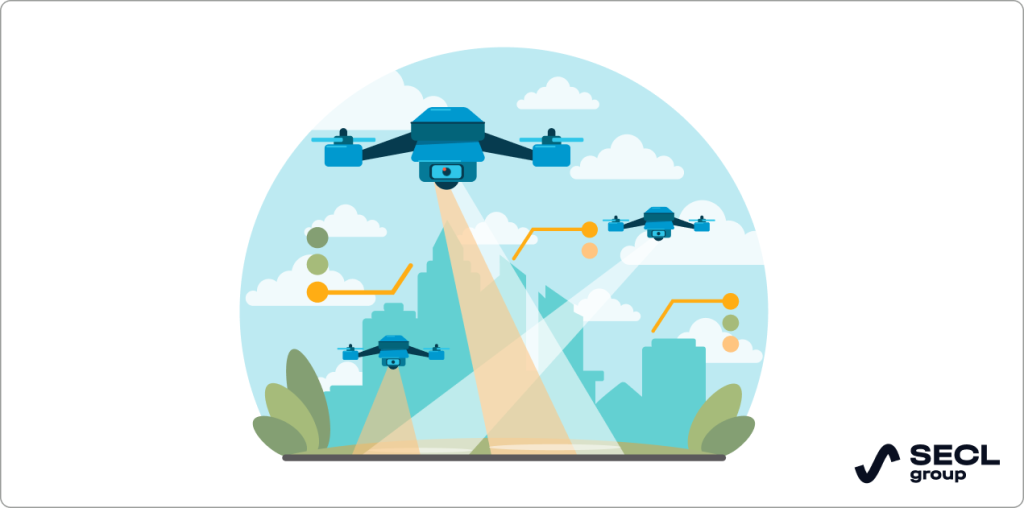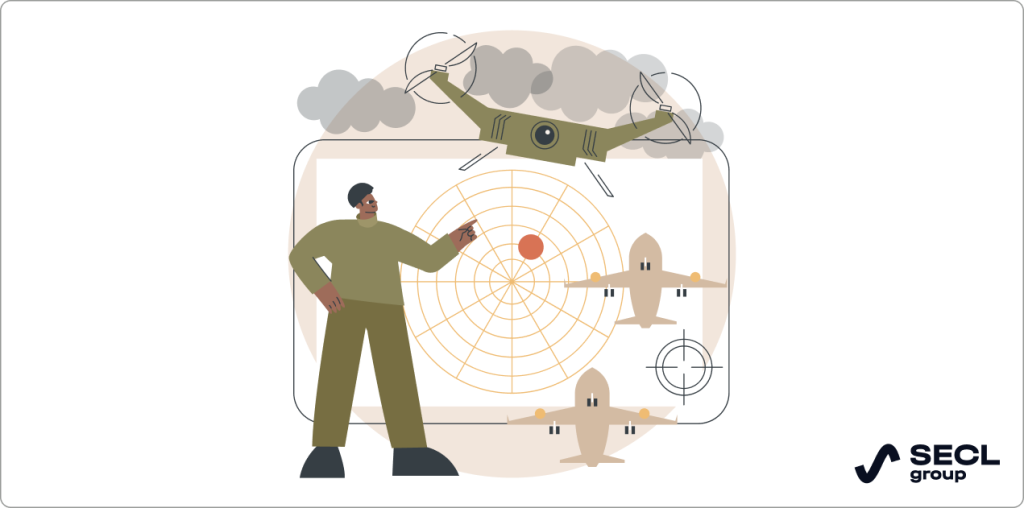- What are FPV Drones and How They Work
- The Specifics of FPV Drone Hardware
- Software Features for FPV Drone App Development
- The Use of AI in Custom FPV Drone Development
- Wrapping Up on Military FPV Drone Development
Drones have the potential to dramatically change battlefield dynamics. Among other types of UAVs, FPV (first-person-view) drones are likely to be the most widely used drone type in modern warfare.
According to recent statistics, there has been a rapid increase in FPV drone usage during the Russian-Ukrainian war. In 2022, such use was minimal, but it has since escalated to potentially hundreds of thousands. And this estimate doesn’t take into account the numerous unreported strikes that FPV drones are thought to be responsible for.
That’s why custom FPV drone development is now in such high demand across military circles. In this article, we will talk about the specifics of military FPV drone hardware and software, and we’ll illustrate our expertise with examples from the drone software development projects that we have worked on.
What are FPV Drones and How They Work
These drones have a real-time video transfer function from a camera installed at the front of the UAV, which enables the person controlling the UAV to function as though they are directly involved in the military operation themselves. The operator can observe the area around the drone in real-time using special glasses as if they were inside the drone. This replicates the experience that military pilots have.

Initially, these UAVs were used for civilian purposes only. For instance, they could be used to take aerial photos and videos, for racing, or for security and surveillance. For these purposes, you can use ordinary drone programs. However, FPV drones can be further modified and used for military purposes, including:
- surveillance and monitoring of large areas;
- target acquisition;
- self-destructing drone attacks (loitering munition);
- personnel protection.
The key characteristics that make FPV drones suitable for these missions are numerous. Firstly, they are more lightweight and manoeuvrable than drones with similar characteristics as they don’t have as many sensors attached to them. They are compact and lightweight, which leads to increased top speeds. Modern FPV drones can fly at 200 km/h compared to other drone types that max out at 50 kmph. For instance, the Chinese DJI Mavic 3, which has become “the classic” of the Ukrainian battlefield, reaches speeds of up to 160 kmph. FPV drones can be used as kamikaze drones or for dropping missiles, which makes them versatile and easy to combine with different types of munitions, from grenades to heavier explosives.
The Specifics of FPV Drone Hardware
Other than the drone itself, a screen, or video goggles are essential components of FPV drone hardware. You can also incorporate supportive equipment, such as a battery charger, spare parts, or tools. The UAV’s componentry, including frames, cameras, and electronics are made from lightweight materials like carbon fiber and aluminum. This optimizes vehicle weight without sacrificing durability and allows for the placement of more sensors or high-resolution cameras. Yet, these materials are also suitable for withstanding high-speed flights and occasional crashes.
FPV drones have high-performance brushless motors and efficient propellers required for rapid acceleration and agile movement. Motors are typically optimized for high RPMs and torque, which allows you to change direction and speed quickly.
Their customizability and modularity have resulted in these hobbyist UAVs becoming so widely used on the battlefield. These features allow pilots to tailor their drones to their specific needs and preferences. You can easily upgrade or swap out cameras, antennas, and flight controllers for alternatives to improve performance or facilitate different operations.
There are different ways to change UAVs from civilian to military use. Adding explosives transforms them into kamikaze drones. They can also carry grenades or other small munitions which can be dropped on enemy positions. High-resolution or thermal imaging cameras are installed to provide better situational awareness and target identification in different conditions. Some UAVs may have anti-jamming capabilities to maintain a stable signal and control.
It is hardware that is decisive for custom FPV drone development, and software should comply with the drone’s technical characteristics and intended purpose. For instance, lightweight FPV drones may not be suitable for carrying heavy missiles as they can impact negatively upon their speed, flight duration, and overall effectiveness.
Software Features for FPV Drone App Development
Developing suitable software is essential for the success of your drone operations. An FPV drone control app should include features for real-time video or image transmission, as well as flight parameter adjustments. You also need to pay attention to compatibility with different tablet or mobile devices and controllers.

Here are some must-have features for your military FPV drone app development.
- Encrypted communication that makes data exchange between the drone and ground control station more secure.
- Changing frequencies or having several drones at different frequencies minimizes vulnerability to EW (electronic warfare) stations.
- Real-time video transmission enables the instant sharing of data from the drone’s onboard cameras to a ground control station.
- Onboard sensor integration allows for the transmission of data from various onboard elements to achieve a holistic view of the operational area.
- Compliance features that ensure the drone meets relevant aviation regulations, military standards, and operational guidelines.
- Manual flight control allows operators to take direct control of the UAV and change flight parameters in-flight.
- An autonomous flight feature is a predefined flight mode that supports diverse mission objectives and operational scenarios.
- Target identification allows for the recognition of an enemy’s machinery or troops; attacking if necessary. It also features automated guidance to the captured target for accuracy.
- EW resistance minimizes the impact of EW systems and allows your UAV to operate in different conditions.
- Vertical flight features make it possible for the drone to hover over a target, and ensure that the UAV can stay in the same position for a long time.
- Aiming and dropping munitions can be automated or set manually by the UAV pilot.
You also need to bear in mind that this feature set only includes the bare essentials. You can further modify the spec according to your needs, preferences, and drone models used. Consult with our experienced specialists – who have been involved in several drone app development projects – to determine the optimal functionality for your FPV drone software.
The Use of AI in Custom FPV Drone Development
The Russians now actively use EW signals. These work on any frequency by blocking the signal, rendering the drone inoperable right before it hits its target. That’s why implementing AI in drone control is necessary to prevent this unwanted complication.
In this scenario, a UAV approaches its target until it reaches a certain distance away, from where the pilot locks on to it. The drone then guides itself towards the target and attacks without further human intervention. This means that EW signal blocking is useless.
The only complication is that the Russians place metal sheets, nets, and other obstacles in positions that protect their armored vehicles. In such cases, a human operator can locate the most vulnerable places and attack effectively, but AI may not recognize these areas and attack the outer shell without causing substantial damage to the vehicle itself. Developing AI algorithms that take this into account is more challenging, yet still possible.
Implementing AI algorithms can streamline your UAV control and simplify military operations when using FPV drones. Here are just a few ways of using AI in FPV drone software development.
For instance, you can program your drone with autonomous path-planning features that help navigate complex environments, identify and ignore EW signals, avoid obstacles, and optimize routes based on mission objectives and real-time data. You can also implement autonomous return functionality whereby the drone records its route and returns to its starting point without human intervention.
You can also integrate computer vision algorithms powered by AI. This helps an FPV drone detect and recognize objects of interest in its field of view, such as vehicles, buildings, and individuals. Among other applications, adding these algorithms mean that UAVs can be used in search and rescue missions. Furthermore, they are also equipped to recognize machinery and determine whether it belongs to friend or foe.
AI can also be used for real-time collision avoidance, enabling drones to detect and react to obstacles along their flight path. This prevents collisions and ensures safe navigation in dynamic environments or in areas with weak communication with the control center. At SECL Group, our team has experience in implementing AI algorithms that enhance drone operations.
Wrapping Up on Military FPV Drone Development
As UAVs developed initially for purposes like aerial photography and videography, these drones have been repurposed for military use and have become game-changers in modern battlefields.
Their customizability and versatility allow them to take part in various missions and perform a wide range of tasks. FPV drones are more cost-effective than artillery missiles, which is one of the most pressing reasons for them being in such a high demand.
If you are interested in creating a custom FPV drone app, contact us for a consultation. Our team has extensive experience in developing drone apps for both civilian and military applications, and we can help you build your app according to the specific needs of your domain.